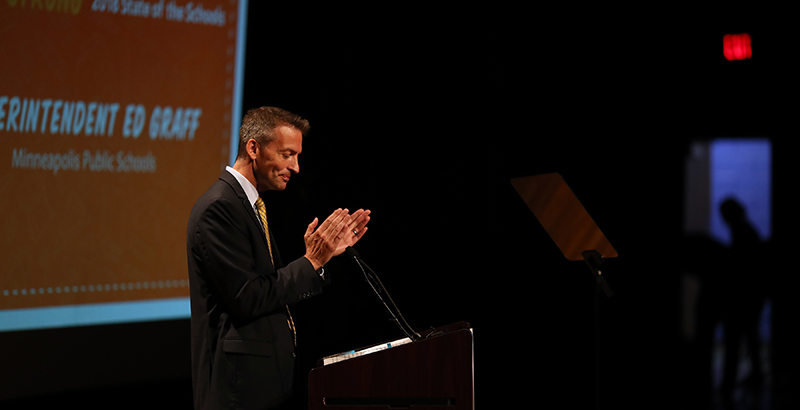Minneapolis School District Addresses Parent Outrage Over New Digital Surveillance Tool as Students Learn Remotely

The Minneapolis school district addressed its new contract with a controversial digital student surveillance tool at a board meeting Tuesday, arguing that despite alarm from parents, monitoring children online is required by federal law.
But student privacy experts said the issue isn’t so cut and dried. Amelia Vance, director of the Youth and Education Privacy Project at the Washington, D.C.-based Future of Privacy Forum, challenged the district’s assertion as being “a little disingenuous.”
Schools’ use of sophisticated online surveillance isn’t “actually required, mostly because we don’t know what is required,” said Vance, who noted that the Clinton-era Children’s Internet Protection Act has long been a matter of confusion, especially because the internet has evolved dramatically since the era of Windows 98. “In fact, monitoring has become more ethically and legally problematic as students are learning more and more from home.”
Since the pandemic shuttered schools across the country last spring, the Minneapolis district and school systems in more than 100 cities have partnered with the surveillance company Gaggle, which uses artificial intelligence and a team of moderators to scan billions of student emails, chat messages and files each year in search of references to violence, self-harm and misbehavior. As first reported this month by The 74, the Minneapolis district has shelled out more than $355,000 this year for the service — a revelation that alarmed civil rights activists who’ve likened the service to pervasive government surveillance.
During the school board meeting, Chairwoman Kim Ellison said she was contacted by several people who were concerned that communications flagged by Gaggle could wind up in the hands of police — a fraught issue in Minneapolis after George Floyd died at the hands of a city officer and the district ended its longstanding relationship with the local law enforcement agency. Citing the district’s internet use policy, Superintendent Ed Graff didn’t rule out the possibility. The policy notes that students should “expect only limited privacy,” and that those who misuse district technology could be subjected to student discipline and “civil or criminal liability under applicable laws.” The district didn’t respond to a request for comment.
During the meeting, Minneapolis education officials cited the Children’s Internet Protection Act to justify their new surveillance tool, and noted that they were simply ensuring compliance with the rules.
Filtering out inappropriate content, like references to drugs and weapons, “is something that the school district in Minneapolis has been doing for many years now,” Senior Officer Justin Hennes said during the meeting. But after the pandemic moved learning online, the district implemented a new tool “so we’re able to continue that web filtering while students were participating in distance learning.”
Under the federal law — and as a condition to receiving federal E-Rate technology funding — districts are required to filter images that are “obscene, child pornography,” or are considered “harmful to minors.” It also requires “monitoring” students’ online activities. But when the rules were created more than a decade ago, monitoring “was a teacher looking over a kid’s shoulder in a computer lab,” Vance said.
Since technology has advanced, she said, “schools have taken wildly divergent approaches to [Children’s Internet Protection Act] compliance.” Vance said she isn’t aware of a school district ever losing E-Rate funding because they didn’t monitor students enough, but she acknowledged that a lack of clarity in the law puts districts “between a rock and a hard place.”
If they don’t do enough to monitor students, districts could be sued for doing too little to stop issues like cyberbullying. Meanwhile, if they monitor students online but miss a legitimate threat, district officials could find themselves in court. Taking surveillance too far could be the most problematic, she said, citing a lawsuit that was settled in 2010. In that case, a suburban Philadelphia school district paid $610,000 to settle a lawsuit after it used webcams on school-issued laptops to covertly take thousands of pictures of students while they were at home.
Gaggle officials say their tool is necessary to help schools identify students who might harm themselves and noted that the pandemic has taken a toll on students’ emotional wellbeing. In an email, the district’s manager of counseling services, Derek Francis, said the district “wanted to make sure we were proactive in having students understand the importance of internet safety,” and that “by no means is Gaggle a replacement for our mental health support.” He didn’t respond to requests seeking further comment.
But as districts look to comply with the law while protecting students, Vance recommended that they be wary of tools — including Gaggle — that aren’t backed by independent research proving they’re effective in keeping kids safe.
Elizabeth Laird, the senior fellow of student privacy at the Center for Democracy and Technology, offered a similar perspective.
School districts “have wide discretion about how to satisfy those requirements and are under no obligation to use a monitoring tool like Gaggle,” she said in an email. “These requirements have been in place for almost 20 years, well before the proliferation of automated student monitoring algorithms in education, so there are alternative options that have been available for almost two decades.”
Federal officials have never made clear whether student technology rules apply to those learning from home because they were written to govern “school computers hardwired to school networks,” she said.
As Minneapolis and other districts turn to surveillance tools like Gaggle during pandemic-induced remote learning, Vance said they could find themselves facing lawsuits alleging their practices violate the U.S. Constitution. Under the Fourth Amendment, the government is prohibited from subjecting people to unreasonable searches.
“Courts have historically found that the home is a sanctuary, that any searches of the home — whether digital or physical — end up becoming a massive Fourth Amendment issue,” she said. As students’ bedrooms become makeshift classrooms, “I haven’t seen many schools thinking about these implications as they’ve added additional monitoring.”
Get stories like these delivered straight to your inbox. Sign up for The 74 Newsletter

;)
